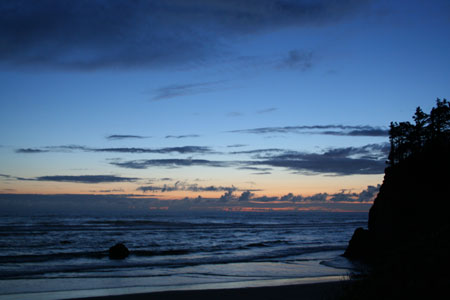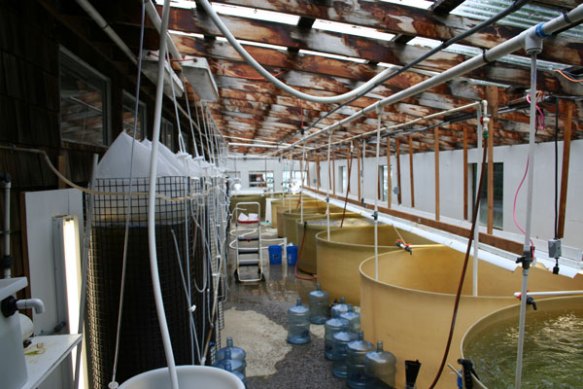West Coast media outlets (minor and major) have honed in on the mysterious upsurge of Vibrio tubiashii in shellfish beds, larvae producers, and coastal waters. The bacterium preys on oyster and other shellfish larvae, with toxins weakening and eventually killing the organism. One important clue may be that Vibrio is responding to climate-induced changes in coastal waters. Below is the synopsis from the Monday, June 9th edition of the Oregonian (written by Michael Milstein).
 An invisible microbe that thrives in warm ocean water has undermined the Northwest’s prized oyster supply, killing billions of young larvae that mature into the succulent shellfish known across the world.
An invisible microbe that thrives in warm ocean water has undermined the Northwest’s prized oyster supply, killing billions of young larvae that mature into the succulent shellfish known across the world.
The bacterium, Vibrio tubiashii, is related to another species that can sicken people who eat raw shellfish. This one doesn’t bother people — it kills shellfish in their larval stage, before they latch onto rocks to grow.
An explosion of the microbe late last summer shut down an Oregon shellfish hatchery that is one of the largest on the West Coast, supplying larvae to about 70 oyster growers the way seed companies provide crop seed to farmers.
The microbe also is the likely culprit in the disappearance of recent generations of wild oysters from usually prolific estuaries such as Willapa Bay on the southern Washington coast.
“We’re in a state of panic,” said Robin Downey, executive director of the Pacific Coast Shellfish Growers Association, based in Olympia. “There is no other word for it.”
The crisis has the attention of local and state leaders, including the governor. And scientists have rushed to devise filters that can strain the lethal bacterium out of water flowing through hatcheries.
Researchers say the rise of bacteria might be tied to the same unusual ocean conditions — possibly connected to global climate change — causing the suffocating “dead zones” that have appeared off the Oregon coast in recent summers.
The bacteria, long known in coastal waters at low levels, seem to have taken off in the same areas and about the same times as the dead zones. But it’s unclear what conditions have caused the bacteria to thrive.
“It’s safe to say it’s probably all of Oregon and parts of California and Washington,” said Ralph Elston, a veterinarian with Aquatechnics in Sequim, Wash., who works with shellfish hatcheries.
Oysters grow for a few years before they’re big enough to eat, so those showing up in restaurants now predate the recent bacterial boom that killed young oysters. Growers predict the loss of those generations of oysters will shrink supply and probably drive up prices later this year.
“It’s going to have some major effects on the industry in the next year or so,” said Bill Taylor of Taylor Shellfish Farms, which hatches and grows oysters on Washington’s Hood Canal and also has been hammered by the bacteria this spring. “There’s not going to be enough marketable oysters to sell.”
Besides oysters, geoducks grown farther north on the West Coast are at risk. Clams and mussels seem less vulnerable, though fisheries officials have noticed a lack of young razor clams along some areas of the coast.
Hatcheries sound alarm
State biologists don’t monitor wild shellfish as they do key fish species such as salmon. Shellfish hatcheries, which grow larvae in water pumped from the ocean, were the first to realize that young oysters were dying.
“The hatcheries are really the canary in the mine shaft,” said Chris Langdon, a professor at Oregon State University’s Hatfield Marine Science Center in Newport. “There hasn’t been monitoring of this bacteria on large scales.”
West Coast growers produce more than $100 million worth of commercial shellfish each year, with oysters by far the largest share. Cultivated oysters are mainly Pacific oysters, originally imported from Japan and different from native West Coast oysters.
But researchers said the bacteria probably also are affecting wild shellfish.
Oyster larvae suddenly disappeared from Willapa Bay last year, said Alan Trimble, a University of Washington researcher who works at the bay. He suspects the bacteria contributed to poor reproduction of native oysters and razor clams in bays and coastal beaches.
“When the larvae die in the water column, it isn’t just Pacific oysters; the others disappear also,” he said in an e-mail from Namibia, where he is on leave.
That could affect the rest of the marine food chain, because many other forms of marine life eat young shellfish.
Business shuts down
Late last summer, the bacteria multiplied to levels that shut down Whiskey Creek Hatchery on Netarts Bay. Tiny oyster larvae that usually swim busily under a microscope instead looked shrunken and feeble as a toxic enzyme secreted by the bacteria destroyed them, said Sue Cudd, who, with her husband, Mark Wiegardt, runs the hatchery.
The hatchery usually produces many billions of oyster larvae each year but couldn’t produce any once the bacteria invaded in August. Wiegardt and Cudd had nothing to send to growers that depend on them for their seed stock.
“We have the weight of a lot of people depending on us,” Wiegardt said. “If we don’t figure out this problem, people are going out of business.”
The hatchery burned through its reserve funds and was about to give up. “I had nowhere to go,” Cudd said.
Then the couple found help from the Hatfield Marine Science Center, which had similar trouble at its hatchery in 2005. Researchers there developed a filtration system that uses a combination of ultraviolet light and other methods to remove the bacteria from water entering the hatchery.
Other shellfish growers, many of them the hatchery’s customers, donated money to hire Alan Barton, a former Hatfield researcher, to design a similar system at the Whiskey Creek hatchery.
That’s now up and running at a cost of about $180,000, although it handles only enough water for the hatchery to produce about half its normal oyster crop of close to 50 million larvae a day. It will cost an additional $80,000 to expand the system to provide a full water supply.
“This affects a huge West Coast oyster industry that goes all the way to the oysters on your plate,” said Mark Labhart, a Tillamook County commissioner who is trying to help the hatchery find financial assistance to boost the filter system.
Finding out why
Concentrations of Vibrio have spiked as high as 1 million in 1 milliliter of water — at least 100 times usual levels — and remain higher than normal, Barton said. The bacterium also took off in 1998, when an El Nino pattern warmed coastal waters, though not nearly as severely as it has recently, Elston said.
He suspects some of the same factors Oregon State researchers have connected with dead zones along the coast: strong but intermittent upwelling of deep water that pushes rich nutrients toward the surface.
Langdon said the deep water also might be a source of the oyster-killing bacteria.
Though the deep water is cold, its nutrients could combine with warm surface waters to nourish the microbes, Elston said. “The conditions were just absolutely optimal for a bloom.”
The bacteria might now have collected in the sediments of inlets and bays, and Wiegardt can’t help but wonder what’s happening to wild shellfish in the oceans. “I don’t think it’s just about us anymore. It’s about what’s going on in the marine environment.”





